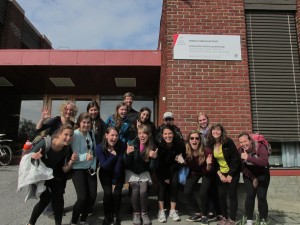 Frozen yogurt and paninis in hand, our group rode the Troms county bus some steep kilometres up from the Tromsø city center to the University of Tromsø’s Geophysical Observatory, located on the highest point of Trømsoya island. From the bus stop, it was a quick stroll by the glistening Prestvannet lake. With the early June sun warming our backs, we approached the red bricked building all smiles and ready to learn of ongoing research on arctic solar technology.
Frozen yogurt and paninis in hand, our group rode the Troms county bus some steep kilometres up from the Tromsø city center to the University of Tromsø’s Geophysical Observatory, located on the highest point of Trømsoya island. From the bus stop, it was a quick stroll by the glistening Prestvannet lake. With the early June sun warming our backs, we approached the red bricked building all smiles and ready to learn of ongoing research on arctic solar technology.
We met with Professor Tobias Boström, a fervent believer in the thusfar largely undeveloped and undervalued arctic wind and solar resources. He deconstructed the notion that the arctic region is lacking in available sunlight and even furthered our estimations by asserting that lowering temperatures by 40 °F can enhance generation efficiencies by 10%.
Owed to variances in the sun’s position in the arctic circle, Professor Boström is investigating new tracking photovoltaics that can rotate to meet the sun perpendicularly and maximize the incoming energy density (as opposed to conventional horizontal panels that work for equatorial regions where the sun is overhead). The tracking systems’ mobility enhances the extractable portion immensely and makes latitudinal differences negligible. In the field, five tracking models of 20 to 30 units were tested in Piteå, Sweden and the generated amounts in 2012 and in 2013 were comparable to the amount produced by horizontal systems in the sunny Mediteranean. And, because of cold temperature related increases in efficiency, a 115% peak power (under standard conditions of 1000 watts per square metre) breakthrough was reported for March of last year.
Despite the cold climate benefits, snow and icing still pose technical restraints. Accumulated snow and bird droppings cause shadowing that inhibit incoming solar rays but there are natural equivalents everywhere, such as debris shadowing in Texas where the systems are not rinsed off as often from precipitation.
From our course background and independent research projects we were aware of the expensive materials and high initial costs of photovoltaic systems. Professor Boström did not deny the expense or the fact that the Norwegian government does not subsidize the industry because the majority of Norway’s generated electricity is already sustainable hydropower. Once plants are installed however, the running and production costs are mere shavings. The price per kWh for solar power has dropped from $0.70 in 2009 to just $0.20 in 2014, making it cost competitive with hydrocarbon-based electricity in Europe.
Renewable energies’ annual and daily intermittency results in their inability to match real-time electricity demands. Such fluxes and unpredictability necessitates storage technology invention and implementation on a grand scale. Additionally important is the amount of land dedicatable to large-scale solar power farms, but Professor Boström assured there being minimal “not in my backyard” opposition in northern Scandinavia. Our class participated in this year’s Energy in the 21st century Symposium at Syracuse and learned that lacking storage technologies remains a blockade for intermittent energy resources.
Though other lectures we attended celebrate Norway’s established hydropower capacity, Professor Boström is determined to move forward and views arctic solar and wind as moral imperatives. He promotes the hybridization of solar and wind power storage and inspired us to tackle the contemporary challenge. Tusen takk, Professor Boström!
 Frozen yogurt and paninis in hand, our group rode the Troms county bus some steep kilometres up from the Tromsø city center to the University of Tromsø’s Geophysical Observatory, located on the highest point of Trømsoya island. From the bus stop, it was a quick stroll by the glistening Prestvannet lake. With the early June sun warming our backs, we approached the red bricked building all smiles and ready to learn of ongoing research on arctic solar technology.
Frozen yogurt and paninis in hand, our group rode the Troms county bus some steep kilometres up from the Tromsø city center to the University of Tromsø’s Geophysical Observatory, located on the highest point of Trømsoya island. From the bus stop, it was a quick stroll by the glistening Prestvannet lake. With the early June sun warming our backs, we approached the red bricked building all smiles and ready to learn of ongoing research on arctic solar technology.
